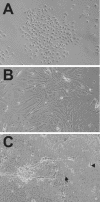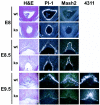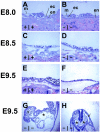Placental failure and impaired vasculogenesis result in embryonic lethality for neuropathy target esterase-deficient mice
- PMID: 14749382
- PMCID: PMC344166
- DOI: 10.1128/MCB.24.4.1667-1679.2004
Placental failure and impaired vasculogenesis result in embryonic lethality for neuropathy target esterase-deficient mice
Abstract
Age-dependent neurodegeneration resulting from widespread apoptosis of neurons and glia characterize the Drosophila Swiss Cheese (SWS) mutant. Neuropathy target esterase (NTE), the vertebrate homologue of SWS, reacts with organophosphates which initiate a syndrome of axonal degeneration. NTE is expressed in neurons and a variety of nonneuronal cell types in adults and fetal mice. To investigate the physiological functions of NTE, we inactivated its gene by targeted mutagenesis in embryonic stem cells. Heterozygous NTE(+/-) mice displayed a 50% reduction in NTE activity but underwent normal organ development. Complete inactivation of the NTE gene resulted in embryonic lethality, which became evident after gastrulation at embryonic day 9 postcoitum (E9). As early as E7.5, mutant embryos revealed growth retardation which did not reflect impaired cell proliferation but rather resulted from failed placental development; as a consequence, massive apoptosis within the developing embryo preceded its resorption. Histological analysis indicated that NTE is essential for the formation of the labyrinth layer and survival and differentiation of secondary giant cells. Additionally, impairment of vasculogenesis in the yolk sacs and embryos of null mutant conceptuses suggested that NTE is also required for normal blood vessel development.
Figures










Similar articles
-
Glial expression of Swiss cheese (SWS), the Drosophila orthologue of neuropathy target esterase (NTE), is required for neuronal ensheathment and function.Dis Model Mech. 2016 Mar;9(3):283-94. doi: 10.1242/dmm.022236. Epub 2015 Dec 3. Dis Model Mech. 2016. PMID: 26634819 Free PMC article.
-
Neuronal differentiation of NTE-deficient embryonic stem cells.Biochem Biophys Res Commun. 2005 May 20;330(4):1103-9. doi: 10.1016/j.bbrc.2005.03.090. Biochem Biophys Res Commun. 2005. PMID: 15823557
-
Functional pathways altered after silencing Pnpla6 (the codifying gene of neuropathy target esterase) in mouse embryonic stem cells under differentiation.In Vitro Cell Dev Biol Anim. 2014 Mar;50(3):261-73. doi: 10.1007/s11626-013-9691-4. Epub 2013 Oct 19. In Vitro Cell Dev Biol Anim. 2014. PMID: 24142151
-
Neuropathy target esterase and phospholipid deacylation.Biochim Biophys Acta. 2005 Sep 15;1736(2):87-93. doi: 10.1016/j.bbalip.2005.08.002. Biochim Biophys Acta. 2005. PMID: 16137924 Review.
-
Roles of NTE protein and encoding gene in development and neurodevelopmental toxicity.Chem Biol Interact. 2016 Nov 25;259(Pt B):352-357. doi: 10.1016/j.cbi.2016.07.030. Epub 2016 Jul 28. Chem Biol Interact. 2016. PMID: 27475862 Review.
Cited by
-
Inhibition of neuropathy target esterase expressing by antisense RNA does not affect neural differentiation in human neuroblastoma (SK-N-SH) cell line.Mol Cell Biochem. 2005 Apr;272(1-2):47-54. doi: 10.1007/s11010-005-6753-2. Mol Cell Biochem. 2005. PMID: 16010971
-
DNA Methylation of Patatin-Like Phospholipase Domain-Containing Protein 6 Gene Contributes to the Risk of Intracranial Aneurysm in Males.Front Aging Neurosci. 2022 Jul 11;14:885680. doi: 10.3389/fnagi.2022.885680. eCollection 2022. Front Aging Neurosci. 2022. PMID: 35898327 Free PMC article.
-
Genetics of Combined Pituitary Hormone Deficiency: Roadmap into the Genome Era.Endocr Rev. 2016 Dec;37(6):636-675. doi: 10.1210/er.2016-1101. Epub 2016 Nov 9. Endocr Rev. 2016. PMID: 27828722 Free PMC article. Review.
-
Spongiform pathology in mouse CNS lacking 'neuropathy target esterase' and cellular prion protein.Neurobiol Dis. 2009 Sep;35(3):433-7. doi: 10.1016/j.nbd.2009.06.001. Epub 2009 Jun 11. Neurobiol Dis. 2009. PMID: 19524041 Free PMC article.
-
Knockdown of Pnpla6 protein results in motor neuron defects in zebrafish.Dis Model Mech. 2013 Mar;6(2):404-13. doi: 10.1242/dmm.009688. Epub 2012 Sep 20. Dis Model Mech. 2013. PMID: 22996643 Free PMC article.
References
-
- Anson-Cartwright, L., K. Dawson, S. J. Fisher, R. A. Lazzarini, and J. C. Cross. 2000. The glial cells missing-1 protein is essential for branching morphogenesis in the chorioallantoic placenta. Nat. Genet. 25:311-314. - PubMed
-
- Carmeliet, P., V. Ferreira, G. Breier, S. Pollefeyt, L. Kieckens, M. Gertsenstein, M. Fahrig, A. Vandenhoeck, K. Harpal, C. Eberhardt, C. Declercq, J. Pawling, L. Moons, D. Collen, W. Risau, and A. Nagy. 1996. Abnormal blood vessel development and lethality in embryos lacking a single VEGF allele. Nature 380:435-439. - PubMed
-
- Colosi, P., F. Talamantes, and D. I. Linzer. 1987. Molecular cloning and expression of mouse placental lactogen I complementary deoxyribonucleic acid. Mol. Endocrinol. 1:767-776. - PubMed
-
- Cross, J. C., M. L. Flannery, M. A. Blanar, E. Steingrimsson, N. A. Jenkins, N. G. Copeland, W. J. Rutter, and Z. Werb. 1995. Hxt encodes a basic helix-loop-helix transcription factor that regulates trophoblast cell development. Development 121:2513-2523. - PubMed
-
- Ehrich, M., and B. S. Jortner. 2001. Organophosphorus-induced delayed neuropathy, p. 987-1012. In R. Krieger (ed.), Handbook of pesticide toxicology, 2nd ed. Academic Press, San Diego, Calif.
Publication types
MeSH terms
Substances
LinkOut - more resources
Full Text Sources
Other Literature Sources
Molecular Biology Databases
Research Materials
